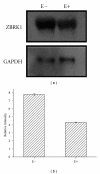Novel stromal biomarkers in human breast cancer tissues provide evidence for the more malignant phenotype of estrogen receptor-negative tumors
- PMID: 21976967
- PMCID: PMC3185288
- DOI: 10.1155/2011/723650
Novel stromal biomarkers in human breast cancer tissues provide evidence for the more malignant phenotype of estrogen receptor-negative tumors
Abstract
Research efforts were focused on genetic alterations in epithelial cancer cells. Epithelial-stromal interactions play a crucial role in cancer initiation, progression, invasion, angiogenesis, and metastasis; however, the active role of stroma in human breast tumorigenesis in relation to estrogen receptor (ER) status of epithelial cells has not been explored. Using proteomics and biochemical approaches, we identified two stromal proteins in ER-positive and ER-negative human breast cancer tissues that may affect malignant transformation in breast cancer. Two putative biomarkers, T-cell receptor alpha (TCR-α) and zinc finger and BRCA1-interacting protein with a KRAB domain (ZBRK1), were detected in leukocytes of ER-positive and endothelial cells of ER-negative tissues, respectively. Our data suggest an immunosuppressive role of leukocytes in invasive breast tumors, propose a multifunctional nature of ZBRK1 in estrogen receptor regulation and angiogenesis, and demonstrate the aggressiveness of ER-negative human breast carcinomas. This research project may identify new stromal drug targets for the treatment of breast cancer patients.
Figures




References
-
- Shipitsin M, Campbell LL, Argani P, et al. Molecular definition of breast tumor heterogeneity. Cancer Cell. 2007;11(3):259–273. - PubMed
-
- Man YG. Focal degeneration of aged or injured myoepithelial cells and the resultant auto-immunoreactions are trigger factors for breast tumor invasion. Medical Hypotheses. 2007;69(6):1340–1357. - PubMed
-
- Allinen M, Beroukhim R, Cai L, et al. Molecular characterization of the tumor microenvironment in breast cancer. Cancer Cell. 2004;6(1):17–32. - PubMed
-
- Radisky D, Hagios C, Bissell MJ. Tumors are unique organs defined by abnormal signaling and context. Seminars in Cancer Biology. 2001;11(2):87–95. - PubMed
Publication types
MeSH terms
Substances
Grants and funding
LinkOut - more resources
Full Text Sources
Other Literature Sources
Medical
Miscellaneous

